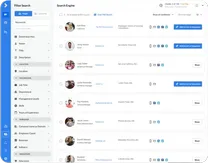
According to Invoca, 65% of people in business choose to contact by phone. Hence, if you want to ensure optimal business growth, you have to know how to deal with different types of sales calls.
Whether it’s cold calls, warm calls, or when customers reach out to you, each interaction matters. And each call has a different purpose, so you’ll have to answer according to that. Yes, you need to customize your pitches uniquely for each client.
Don’t worry; you don’t have to be clueless about these strategies anymore, as we’re here to help. In this article, we’ll tell you about 10 common sales call types in detail.
And we’ll also share why talking in a personal way is key and the follow-up tricks to make lasting connections. Let’s get in.
What are Sales Calls?
A sales call is a communication or conversation between a salesperson or a representative of a company and a potential customer or prospect. They are used across a wide range of industries and business-to-business (B2B) or business-to-consumer (B2C) contexts.
The primary goal of a sales call is to persuade the prospect to take a desired action, such as making a purchase, signing a contract, or scheduling a follow-up meeting.
These calls can take various forms, including phone calls, video calls, or in-person meetings. During a sales call, the salesperson typically engages in a dialogue with the prospect to understand their needs, address any concerns, and highlight the features and benefits of a product or service.
10 Types of Sales Calls to Get Your Pitching Started

Sales calls vary based on the product, industry, and preferences of both the salesperson and the potential customer. We’ll explore 10 common types of these calls to help you understand them better. Let’s check them out.
1. Introductory Calls
An introductory call is a type of communication initiated by a sales representative or business professional to establish the initial connection with a potential prospect or client.
The primary purpose of an introductory call is to create a positive first impression, introduce the company’s products or services, and initiate the process of building a relationship with the prospect.
These calls serve as the starting point in the sales cycle, providing an opportunity for the sales representative to gather information about the prospect’s needs, challenges, and preferences.
Purpose
- Create a positive first impression and establish a connection with the prospect.
- Provide a brief overview of the company’s products or services.
- Understand the prospect’s challenges, needs, and potential pain points.
Questions to Ask During Introductory Calls
- “How do you currently handle [specific process or task related to your offerings] within your organization?”
- “Can you share more about your experience with [relevant industry trend or recent development] and how it’s impacting your business?”
- “What are the key priorities or challenges your company is currently facing?”
2. Discovery Calls
The discovery calls are necessary to figure out what they need, what problems they’re facing, and what they want to achieve. While making these calls, you need to adjust how you sell, find out what’s bothering them, and show how your product or service can solve their problems.
Purpose
- Identify the specific challenges, pain points, and goals of the prospect.
- Establish a positive relationship and build trust with the prospect.
- Learn about the prospect’s decision-making process, key stakeholders, and potential obstacles.
Questions to Ask During Discovery Calls
- “Can you share more about the specific challenges or pain points your organization is currently facing?”
- “Do you have a budget in mind for addressing this challenge or implementing a solution?”
- “What is your desired timeline for implementing a solution or addressing this challenge?”
3. Demo Calls
In the demo calls, you can display how your product works in a demo. You can start by pointing out the great features and advantages and share real-life examples so they can see and understand it for themselves.
Purpose
- Demonstrate the key features and capabilities of the product or service.
- Help prospects visualize how the product or service can address their specific needs.
- Proactively address potential concerns or objections the prospect might have.
- Emphasize the unique selling points and benefits of the product or service.
Questions to Ask During Demo Calls
- “What are the key criteria you’re looking for in a [product or service category] solution?”
- “How do you envision incorporating our [product or service] into your daily operations, and what outcomes are you hoping to achieve?”
4. Cold Calls
Cold calls are one of the most common types of sales calls used to get new prospects. According to RAIN, 82% of customers are willing to meet the salesperson after getting the cold calls.
These involve reaching out to prospects who have had no prior contact with the company. The goal is to introduce the product or service and generate interest.
For example, a cold call can be approaching calling businesses from a purchased lead list to present a new software solution. Or contacting individuals in a specific industry to gauge interest in a consulting service.
Purpose
- Introduce your company, product, or service to prospects who may not be familiar with it.
- Gather information about the prospect’s needs.
- Determine if the prospect is a qualified lead based on their level of interest and fit for your products or services.
Questions to Ask During Cold Calls
- What goals or priorities is your company currently focusing on, and how do you see [your product or service category] fitting into those objectives?”
- How do you see [your product or service] potentially benefiting your team or organization?”
- How are you currently [handling a specific task or process], and are there any pain points in that area?”
5. Warm Calls
A warm call is when you contact someone you’ve connected with before, making the conversation more familiar and friendly than a completely new or cold call.
The warmth can come from various sources, such as a previous engagement, referral, or the prospect’s demonstrated interest in the product or service.
Purpose
- Strengthen relationships with individuals or businesses with whom there has been a previous engagement.
- Reach out to prospects who have shown interest by requesting information, signing up for updates, or expressing curiosity about the product or service.
- Expand business with existing customers by introducing additional products or services.
Questions to Ask During Warm Calls
- “How has your experience been since our last interaction [event, webinar, previous communication]?”
- “Since we last spoke, have there been any changes or developments in your [industry, business, goals] that you’d like to discuss?”
- “Have you had a chance to explore the [information/material] we provided, and do you have any questions or thoughts about it?”
6. Inbound Calls
Inbound calls are about handling prospects who have proactively reached out to the company for information or assistance.
In this conversation, you need to provide information, answer questions, and guide the prospect toward a purchase decision.
Purpose
- Address customer inquiries, questions, or requests for information.
- Assist customers with technical issues, troubleshooting, or resolving problems with products or services.
- Provide detailed information about products or services, helping customers make informed decisions.
Questions to Ask in Inbound Calls
- “How can I assist you today? Could you please provide more details about your inquiry or concern?”
- “Is this your first time interacting with our company, or have you been a customer before?”
- “Are you calling about a specific product, service, or order? If so, could you provide any relevant details or reference numbers?”
7. Outbound Calls
After an introductory interaction, you should contact your potential customers to address any concerns, provide additional information, or move the sales process forward.
Purpose
- Conduct surveys or gather market research data to understand customer preferences, needs, and trends.
- Follow up with leads generated through marketing efforts, events, or inbound inquiries.
- Schedule meetings, demos, or appointments with potential clients or prospects.
Questions to Ask During Outbound Calls
- “Could you tell me more about your current [specific process or situation relevant to your product or service] and any challenges you might be facing?”
- “What criteria do you typically consider when evaluating solutions in our [product or service] category?”
- “What prompted you to explore [your product or service category] at this time? Are there any particular goals or objectives you’re aiming to achieve?”
8. Appointment Setting Calls
These calls aim to schedule a meeting or appointment, either in person or virtually, where the salesperson can provide a more detailed presentation and discuss the product or service further.
Purpose of Appointment Setting Calls
- Schedule appointments for more in-depth discussions, presentations, or demonstrations.
- Create opportunities for face-to-face or virtual interactions to build stronger relationships with prospects or clients.
- Schedule appointments for live product demonstrations or hands-on experiences.
Questions to Ask During Appointment-Setting Calls
- “How does the decision-making process typically work within your organization, and who else is involved in this evaluation?”
- “Are there any specific outcomes or information you’re hoping to gain from our upcoming meeting?”
- “What is your preferred mode of communication or platform for our upcoming meeting? Are there any specific logistics or preferences we should consider?”
9. Closing Calls
Once a prospect has expressed interest and is considered ready to make a decision, a closing call is made to finalize the sale and address any remaining concerns.
Purpose
- Get a commitment from the prospect to move forward with the purchase or desired action.
- Reinforce the value proposition of the product or service.
- Instill a sense of urgency to encourage the prospect to take immediate action.
Questions to Ask During Follow-up Calls
- “Were there any specific features or aspects of our product/service that stood out to you, or anything you feel could better align with your needs?”
- “Could you share your thoughts on the proposal/quote we provided? Is there anything you’d like to modify or discuss further?”
- “Since our last conversation, have there been any changes in your priorities, challenges, or goals that we should be aware of?”
10. Follow-up Calls
These follow-up calls are made to maintain contact with prospects who have shown interest but have not yet made a decision. Research shows that 80% of sales are more likely to increase because of this practice.
Hence, the sales rep should address any lingering questions, provide additional information, and encourage a positive decision with follow-up calls.
Purpose
- Strengthen connections with prospects and customers over time.
- Find out opportunities to introduce additional products or services.
- Share additional details, resources, or information that may have been requested.
- Seek feedback on previous interactions, proposals, or presentations.
Questions to Ask During Follow-up Calls
- “How has your experience been since our last conversation? Are there any specific aspects you’d like to discuss or any feedback you’d like to share?”
- “Have you had a chance to review the information/material we provided after our last discussion? Are there any questions or points you would like more clarification on?”
- “Are there any challenges or obstacles you’ve encountered since our last conversation that we can help address or overcome?”
11. Renewal or Upsell Calls
If you want to get in touch with current customers to renew their contracts or suggest more things to buy, make a renewal call. It will help you maintain a smooth relationship with your clientele and allow you to make more money along the way.
Purpose
- Secure the renewal of an existing contract, subscription, or service agreement.
- Identify opportunities to sell additional products, services, or upgraded features to existing customers.
Questions to Ask During Renewal Calls
- “We’ve appreciated having you as a customer. As your subscription renewal approaches, are there any specific concerns or preferences you’d like to address?”
- “In the past year, we’ve introduced new features that could enhance your experience. Would you be interested in learning more about these updates before your renewal?”
- “Are there any budgetary considerations or specific terms you’d like to discuss for your upcoming renewal? We want to ensure the terms align with your expectations.”
12. Loss Analysis Call
A Loss Analysis Call is a post-sales activity that involves reaching out to prospects or customers who decided not to move forward with a product or service.
The primary purpose of a Loss Analysis Call is to understand the reasons behind the lost opportunity, gather feedback, and gain valuable insights that can inform future sales strategies and improve the overall sales process.
Purpose
- Collect feedback on the prospect’s overall experience with the sales process, including interactions with sales representatives, presentations, and follow-up communications.
- Determine if competitors played a role in the prospect’s decision not to choose your product or service.
- Assess how the prospect perceived the value of the product or service in relation to the offered price.
Questions to Ask During Loss Analysis Calls
- “Thank you for taking the time to speak with us. To start, could you share the primary reasons or factors that influenced your decision not to move forward with our product/service?”
- “Can you provide feedback on your experience with our sales process? Were there specific aspects that stood out to you, either positively or negatively?”
- “Were there any particular features or functionalities that you found lacking in our product or service? How do you think we could enhance our offering to meet your needs better?”
What are the Sales Call Objectives?
Sales call objectives are goals that a salesperson aims to achieve during a sales call. These objectives can vary based on the sales process stage, product or service nature, and the company’s and salesperson’s specific goals. Here are some common objectives for sales calls:

- Build Relationship: Establish a strong, professional rapport with prospects. Engage in conversations to understand their interests and share relevant personal insights, laying the foundation for a trustworthy relationship.
- Gather Information: Understand the customer’s needs and challenges through insightful questions. This understanding allows you to tailor your approach and offer solutions that directly address their specific requirements.
- Educate the Prospects: Offer valuable information about your industry, emerging trends, and how your product fits into this landscape. Positioning yourself as a knowledgeable resource can greatly influence the customer’s decision-making.
- Introduce Your Product or Service: Clearly explain the features and benefits of your product or service. Highlight how it stands out from competitors and tailor your presentation to the customer’s expressed needs and interests.
- Generate Interest: Use engaging storytelling and relevant examples to make your product or service come alive. Capture the customer’s imagination by demonstrating how your offering can positively impact their life or business.
- Deal with Objections: Listen carefully to any concerns and respond with empathy and well-informed answers. Addressing objections effectively can turn skepticism into confidence and trust.
- Set Expectation: Clearly communicate what the customer should expect post-purchase, including support services, product delivery, and ongoing communication. Transparency in setting expectations can greatly enhance customer satisfaction and loyalty.
- Close the Deal: Guide the conversation towards a commitment to purchase. Use persuasive techniques and reassurances to facilitate the customer’s decision-making process, aiming for a clear and positive conclusion.
- Build Trust and Credibility: Demonstrate your industry knowledge and reliability. Being honest and transparent in all interactions will help establish long-term trust and credibility with the customer.
- Create a Positive Experience: Ensure that every interaction is pleasant and memorable. A good experience can lead to repeat business and referrals, which are invaluable for long-term success.
How to Handle Different Types of Sales Calls
Sales calls can vary based on the context, industry, and the specific goals of the call. Let us show you how to handle different types of sales calls.
Cold Call Example
Sales Representative: Hi, this is [Your Name] from [Your Company]. I hope I’m not catching you at a bad time.
We specialize in [product or service], and I wanted to share a brief overview of how we’ve helped companies like yours increase [specific benefit or result]. Can I take a moment to discuss your current challenges and explore if there might be a fit?
Warm Call Example
Sales Representative: Hi [Prospect’s Name], this is [Your Name] from [Your Company]. We spoke briefly at the [event or previous interaction].
I wanted to follow up and see if you had any further questions about our [product or service] and how it could benefit your business. Is now a good time to chat?
Follow-up Call Example
Sales Representative: Hello [Prospect’s Name], it’s [Your Name] again from [Your Company]. I wanted to get in touch and see if you had a chance to review the information we sent over.
Do you have any additional questions or concerns that I can address for you?
Appointment Setting Call Example
Sales Representative: Hi [Prospect’s Name], this is [Your Name]. Based on our previous conversation, it seems like there might be a good fit for our [product or service] to help address [specific challenge]. I’d love to schedule a brief meeting to discuss this in more detail. Are you available for a call next [suggest a date and time]?
Well, keep in mind that the key to successful sales calls is to adapt your approach to the prospect’s needs, actively listen to their concerns, and position your product or service as a solution to their specific challenges. Personalization and genuine interest in helping the prospect are required for building trust and closing deals.
Common Mistakes to Avoid During Sales Calls
Sales calls can be challenging, and avoiding mistakes is essential for success. Let’s take a look at the common mistakes to be aware of and avoid while talking to your prospects.

Lack of Preparation
If you don’t research your prospect’s business or understand their specific needs, your pitch might come across as generic and unimpressive.
Take the time to delve into their industry, challenges, and goals. This shows you’re not just selling a product; you’re offering a tailored solution that resonates with their unique situation.
Over-Talking
Remember, a good sales call is a two-way conversation. If you find yourself doing most of the talking, you might miss out on understanding what your prospect really needs. Balance your pitch by actively listening and encouraging them to share their thoughts and concerns.
Being Too Pushy
It’s easy to get caught up in the excitement of closing a deal, but if you push too hard, you risk making your prospect feel pressured. Instead, focus on being persuasive in a way that highlights how your product or service can genuinely benefit them.
Neglecting Follow-Up
The conversation doesn’t end with the first call. If you don’t follow up, you might miss out on nurturing a potential lead. Keeping in touch shows your prospects that you value their business and are serious about addressing their needs.
Poor Time Management
Long-winded pitches can lose your prospect’s interest. Keep your conversation concise and focused. This ensures you cover all the essential points without overstretching their attention span.
Get Solid Prospects and Tenfold Your Sales with Swordfish AI

Swordfish AI offers an innovative set of tools designed to take your sales experience to a whole new level. Let’s take a detailed look at the key features:
Prospector: Improve Your Sales Growth

With Swordfish’s Prospector, you can enhance your prospecting game and improve your sales growth effortlessly. This tool enables you to create dialing and email lists within seconds, utilizing advanced filters and guarantees an accurate lead generation.
Chrome Extension: Effortless Contact Information Discovery

Swordfish’s Chrome Extension allows you to uncover contact information for anyone online.
By verifying data from various sources such as LinkedIn, Twitter, Facebook, Dribble, GitHub, StackOverflow, Google, and Bing, this extension provides a comprehensive view of potential leads.
File Upload: Enhance Your CRM Contact Database

The File Upload feature simplifies the task of completing your CRM contact database. By allowing you to upload a CSV file, Swordfish smoothly fills in missing cell phone numbers and emails in a matter of seconds.
API Integration: Boost Your Sales Process

Swordfish’s API provides a powerful tool to enhance and enrich your sales process. Trusted by dedicated defense, tech, government agencies, recruiters, and sales professionals, the API flawlessly integrates with your existing systems.
Reverse Search: Find the Missing Pieces

The Reverse Search feature allows you to utilize the information you have to find the information you don’t.
Whether you have a name, company details, email, phone number, or social profile, Swordfish’s Reverse Search locates the person you’re looking for.
Final Verdict
To summarize, learning about different types of sales calls makes you confident about dealing with customers. And if you can manage to have smooth conversations with the customers, there will be significant growth in your sales career. There’s no doubt about that.
Each type of call needs to be dealt with uniquely. The approach you’ve applied in calls won’t be appropriate for the follow-up calls. But as you have finished this article, you don’t have to worry about those issues anymore.
So don’t fret while making any sales calls. Now, you’re prepared to ace the conversation to achieve your goals.
Frequently Asked Questions
When should you use a sales call?
Use a sales call when you have a potential customer who might benefit from your product or service. It’s an opportunity to personally connect, understand their needs, and explain how what you’re offering can be a solution for them.
In what situations should I consider making a warm call instead of a cold call?
You should go for a warm call when there’s some level of prior connection with the prospect. This could be a referral, a previous interaction, or a shared professional network. Warm calls often have a higher success rate because the prospect is already somewhat familiar with you or your company.
How do you determine the best time to make sales calls?
The ideal time for sales calls depends on your target audience. For instance, if you’re calling businesses, mid-morning or mid-afternoon on weekdays might work best. Analyzing response data, considering the prospect’s time zone, and experimenting with different times can help you pinpoint the most effective period for your calls.
What is the role of social media in sales calls?
Social media is a powerful tool in the sales process. It allows you to research prospects, understand their interests, and build rapport before the call. By integrating insights from social media into your sales calls, you can personalize your approach and make your interactions more relevant and engaging.


 View Products
View Products
















